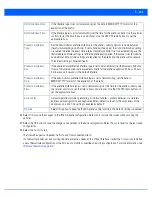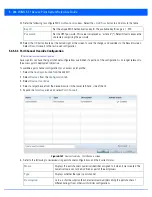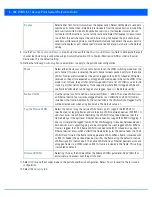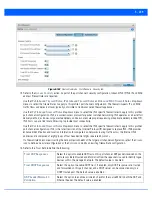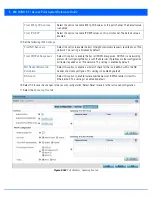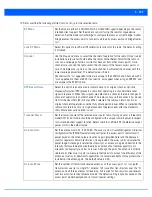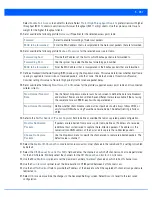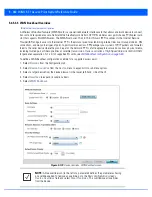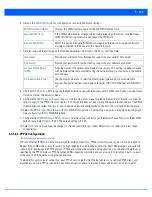
5 - 257
12. Use the
Feed WLAN Packets to Sensor
drop-down menu to allow the radio to send WLAN packet to the sensor radio.
Options include Off, Inline and Promiscuous. The default setting is off.
DTIM Interval
Set a DTIM Interval to specify a period for
Delivery Traffic Indication Messages
(DTIM). A
DTIM is periodically included in a beacon frame transmitted from adopted radios. The
DTIM indicates broadcast and multicast frames (buffered at the access point) are soon to
arrive. These are simple data frames that require no acknowledgement, so nodes
sometimes miss them. Increase the DTIM/ beacon settings (lengthening the time) to let
nodes sleep longer and preserve their battery life. Decrease these settings (shortening
the time) to support streaming multicast audio and video applications that are jitter-
sensitive.
RTS Threshold
Specify a
Request To Send
(RTS) threshold (from 1 - 65,536 bytes) for use by the WLAN's
adopted access point radios. RTS is a transmitting station's signal that requests a
Clear
To Send
(CTS) response from a receiving client. This RTS/CTS procedure clears the air
where clients are contending for transmission time. Benefits include fewer data collisions
and better communication with nodes that are hard to find (or hidden) because of other
active nodes in the transmission path. The default value is 65,536 bytes.
Control RTS/CTS by setting an RTS threshold. This setting initiates an RTS/CTS exchange
for data frames larger than the threshold, and sends (without RTS/CTS) any data frames
smaller than the threshold.
Consider the trade-offs when setting an appropriate RTS threshold for the WLAN's access
point radios. A lower RTS threshold causes more frequent RTS/CTS exchanges. This
consumes more bandwidth because of additional latency (RTS/CTS exchanges) before
transmissions can commence. A disadvantage is the reduction in data-frame throughput.
An advantage is quicker system recovery from electromagnetic interference and data
collisions. Environments with more wireless traffic and contention for transmission make
the best use of a lower RTS threshold.
A higher RTS threshold minimizes RTS/CTS exchanges, consuming less bandwidth for
data transmissions. A disadvantage is less help to nodes that encounter interference and
collisions. An advantage is faster data-frame throughput. Environments with less
wireless traffic and contention for transmission make the best use of a higher RTS
threshold.
Short Preamble
If using an 802.11bg radio, select this option for the radio to transmit using a short
preamble. Short preambles improve throughput. However, some devices (SpectraLink
phones) require long preambles. The default value is disabled.
Guard Interval
Use the drop-down menu to specify a
Long
or
Any
guard interval. The guard interval is the
space between symbols (characters) being transmitted. The guard interval eliminates
inter-symbol interference
(ISI). ISI occurs when echoes or reflections from one symbol
interfere with another symbol. Adding time between transmissions allows echo's and
reflections to settle before the next symbol is transmitted. A shorter guard interval results
in a shorter symbol times which reduces overhead and increases data rates by up to 10%.
The default value is Long.
Probe Response Rate
Use the drop-down menu to specify the data transmission rate used for the transmission
of probe responses. Options include,
highest-basic
,
lowest-basic
and
follow-probe-
request
(default setting).
Probe Response Retry
Select this option to retry probe responses if they are not acknowledged by the target
wireless client. The default value is enabled.
Содержание WiNG 5.7.1
Страница 1: ...WiNG 5 7 1 ACCESS POINT SYSTEM REFERENCE GUIDE ...
Страница 2: ......
Страница 3: ...WING 5 7 1 ACCESS POINT SYSTEM REFERENCE GUIDE MN001977A01 Revision A April 2015 ...
Страница 4: ...ii WiNG 5 7 1 Access Point System Reference Guide ...
Страница 24: ...1 4 WiNG 5 7 1 Access Point System Reference Guide ...
Страница 36: ...2 12 WiNG 5 7 1 Access Point System Reference Guide ...
Страница 72: ...3 36 WiNG 5 7 1 Access Point System Reference Guide ...
Страница 470: ...5 386 WiNG 5 7 1 Access Point System Reference Guide ...
Страница 472: ...6 2 WiNG 5 7 1 Access Point System Reference Guide Figure 6 1 Configuration Wireless menu ...
Страница 624: ...7 46 WiNG 5 7 1 Access Point System Reference Guide ...
Страница 724: ...9 56 WiNG 5 7 1 Access Point System Reference Guide ...
Страница 783: ...12 35 Figure 12 46 Device Summary screen 4 Click File Management ...
Страница 816: ...12 68 WiNG 5 7 1 Access Point System Reference Guide ...
Страница 1006: ...13 190 WiNG 5 7 1 Access Point System Reference Guide ...
Страница 1026: ...14 20 WiNG 5 7 1 Access Point System Reference Guide ...
Страница 1028: ...A 2 WiNG 5 7 1 Access Point System Reference Guide ...
Страница 1089: ......
Страница 1090: ...MN001977A01 Revision A April 2015 ...

